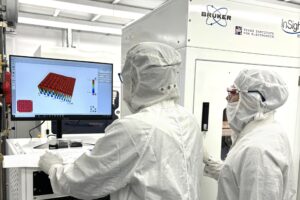AUSTIN, Texas—Using computer imaging to model a fossil of an Archeopteryx animal, a scientific team led by a University of Texas at Austin geologist has provided strong evidence that the forerunner to birds had a brain equipped to handle delicate flight maneuvers.
“This animal had huge eyes and a huge vision region in its brain to go along with that, and a great sense of balance,” said Dr. Timothy Rowe. “Its inner ear also looks very much like the ear of a modern bird.”

|
|
Angela Milner, paleontologist from London’s Natural History Museum, places the skull fragment into the CT scanner in Dr. Timothy Rowe’s lab. |
|
Photo: Marsha Miller |
Rowe co-directs the university’s High-Resolution X-ray Computed Tomography (UTCT) facility, where he was able to help determine the bird-brain features of Archeopteryx from a fossil fragment brought to him by Angela Milner. The paleontologist at London’s Natural History Museum is a co-author of the Nature paper that will be published Aug. 5 about the findings.
Rowe and other scientists revere the 147-million-year-old specimen that was originally discovered in German limestone in 1861 because it was found two years after Charles Darwin published “On The Origin of Species” and supports the theory of evolution. The new findings suggest it will also help define when bird flight began.
Dinosaurs found in China and elsewhere during the past decade have caused scientists to speculate that some had feathers, but couldn’t fly. This research, Rowe said, disproves the theory that Archeopteryx was among those dinosaurs.
Rowe and Dr. Richard Ketcham, who manages the UTCT facility, took 1,300 images of the skull fragment that once held the creature’s brain, eyes and ears using the university’s sophisticated CT scanner. Ketcham then spent months removing artifacts that marred the images so the scientists could reconstruct the size and the features of the brain using 3-D modeling software.
The upper bones that covered the creature’s braincase were overlapped in the squashed fossil. Computer modeling allowed the scientists to reposition the skull bones next to each other as they likely occurred in life. The repositioning suggested that the creature had a brain about three times larger than crocodiles and other modern reptiles, and of a similar size to many modern birds.
“There are living birds that have brains that are relatively smaller than Archeopteryx,” Rowe said.

|
|
The imaged skull fragment of Archeopteryx, an intermediate between dinosaurs and birds. |
|
Photo: Marsha Miller |
Birds are thought to need significant brain power because of the specialized visual and other requirements of flight. High flyers, for example, need to coordinate information coming from their eyes and ears, while relying less on smell. Because of the markings the Archeopteryx brain left inside its skull, the scientists could tell that it had a large midbrain region, where this ear/eye crosstalk would occur, and complex inner ear structures just like birds. However, it had little nervous system hardware to process smells.
Its brain also had a large outer region, or cortex, required to process other complex information during flight, such as the wind pressure detected by nerve cells attached to individual feathers. The bird predecessor would have used that sensory information from wing feathers to make body adjustments during flight.
“The wing of a bird is really much more sophisticated than the wing of an airplane,” said Rowe, who has extensive experience imaging modern birds and other modern and ancient animals.
The scientists’ future studies will focus on how Archeopteryx flew and determining its evolutionary ancestors.
NOTE: High resolution illustrations related to this research are available below with the caption information.
- The skeleton of a 147-million-year-old Archeopteryx lithographica by Dr. Timothy Rowe.
- The comparison of the brain size of a Velociraptor dinosaur that moved on two feet, Archeopteryx and a living bird by Dr. Timothy Rowe.
For more information contact: Barbra Rodriguez, College of Natural Sciences, 512-232-0675.



